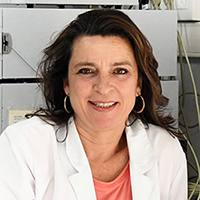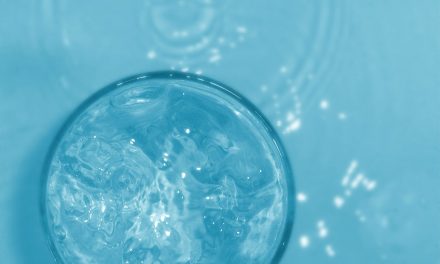Image: Grape marc extracts also hide a well-known antioxidant and antimicrobial power that NeoGiANT wants to unlock by creating solutions for farmers and veterinaries to improve animal health. © Mar de Frades.
DOI.ORG/10.58214/USCN2702
Sometimes, the most everyday things we do can contribute to a bigger cause or be the beginning of something amazing. That is what happened when Marta Lores of the University of Santiago de Compostela, Spain, realised white grape marc, a by-product leftover from white wine production and which is currently categorised as waste, could actually be used to improve animal health. She is now co-ordinator of the Horizon 2020-funded NeoGiANT project, where along with her team, she focuses on the small things that could assist in the fight against antimicrobial resistance.

Profile: Marta Lores graduated in biology and earned a doctorate in chemistry at the University of Santiago de Compostela (USC). A lecturer on analytical chemistry at the Department of Analytic Chemistry, Nutrition and Bromatology, she works in the Investigation Group GI-2085-USC (LIDSA: Laboratorio de Investigación y Desarrollo de Soluciones Analíticas). She has been a researcher and a professor at USC for over 25 years. Image © Santi Alvite/ USC.

Profile: Iciar Serrano graduated in Journalism at the Complutense University of Madrid, specialising in the communication of health, science, technology and environmental issues.
Currently, she works at Contactica (Madrid, Spain), helping to communicate and disseminate the results of European Union-funded projects. Image © Verónica Almeida.
Antimicrobial resistance and its consequences
Let’s start from the beginning. It is possible that Aether readers have come across banners or campaigns at hospitals to reduce the use, or better the misuse, of antibiotics and wonder why there is this urge to reduce them now. The reality is that there is a problem related to the over consumption of antibiotics;
antimicrobial resistance (AMR). In short, microbials adapt to changes in the environment and in the organisms they try to attack. So, these bacteria tend to develop defence mechanisms to survive when they are exposed to antibiotics. And they are adapting to them.
If we take antibiotics when we are not supposed to, they do not act properly against the bacteria, making it more difficult to cure some diseases caused by them. The problem is more serious than it seems, as it is both a health and economic issue. By 2030, AMR could cause a shortfall of up to around €3.1tr (~£2.74tr) per year globally and could be the cause of ten million deaths by 2050, according to the United Nations’ AMR summary for policymakers. Compared to the deaths estimated for cancer the same year (8.2million), it is clear that AMR is a significant threat.
AMR in figures, according to the Pan-European AMR survey, November 2022
-
23% of Europeans have taken antibiotics in the last year;
-
Around 8% of antibiotics were taken without a prescription; and
-
Three out of ten respondents know that using antibiotics when it is not necessary, makes them more ineffective.
Due to this fact, several initiatives have been set in motion during the last years to achieve two things: on the one hand, raising awareness of this great global problem; on the other, developing campaigns with the joint effort of pharmaceuticals and hospitals to decrease the unnecessary consumption and prescription of antibiotics and antimicrobials, so that people don’t overuse them. This seems like an easy task to carry out, but, in reality, doctors and pharmacists face the obstacle of the lack of knowledge about the issue within the general populace.
The last Eurobarometer released at the end of 2022 shows that 50% of the respondents did not know the difference between viruses and bacteria, and a large proportion of Europeans take antibiotics without justification to fight either of them, or to only treat symptoms. The result of this action is that bacteria become immune to antibiotics and they end up being ineffective against diseases, resulting in some cases in their spread and an exacerbation of subsequent human health-related problems.
Virus: a very simple micro-organism that cannot survive on its own. They need a living cell to enter and live in; for example, a human cell. There, they can reproduce and live as infective agents. Influenza, the common cold, herpes or Covid-19 are viral diseases.
Bacteria: single-celled organisms that live inside and outside of our bodies; in our digestive system and our skin, for example. Infectious diseases such as salmonellosis, chlamydiasis or E. coli-related diarrhoea and food poisoning are caused by bacteria.
In any case, it is important not to forget that antibiotics are incredibly useful and necessary medicines; they have saved countless lives, both human and animal. The key is to use them properly – the right antibiotic for the right bacteria and in the right doses. It is the combination of misuse and overuse that generates the phenomenon of AMR, and that is the problem to which NeoGiANT aims to provide solutions.
a problem for humans and animals
Now, human health problems regarding AMR are alarming, but they are no less severe for animals. Cattle, poultry or pigs often receive prophylactic medicines in order to prevent illnesses when they are not supposed to take them. Farmed animals get antibiotics to cure other diseases or tackle different symptoms, with the resultant spread of antimicrobial resistance also occurring in these populations. This can affect human health as well. When humans consume meat and related products from farmed animals that have over-consumed antimicrobials, this excess stays within human organisms. The situation is also common in aquaculture, with the same potential undesirable effects on humans when we eat farmed fish. So, when people go to the supermarket and buy meat or farmed fish, they may get an extra portion of antibiotics in their meal, making their bodies more readily used to these substances and, therefore, entering the circle of the AMR.
The good news is, there are solutions to tackle this global problem but, as the last AMR awareness week campaign said in November 2022: We all must contribute to it. Besides the awareness campaigns and lowering antimicrobial consumption – both in humans and in farmed animals – institutions like the World Health Organization have already released several reports for decision-makers to tackle this problem. But science is also there to develop novel solutions that could save resources, money and lives.
The NeoGiANT extracts grape marc to prevent animal diseases
Marta Lores co-ordinates an €8m awarded project, funded under the Horizon 2020 Research and Development Programme.
NeoGiANT counts on a consortium formed by researchers from several institutions, industrial partners or private companies, making a total of 20 members from nine different countries. Together, they are facing down the problem of AMR in farmed animals to improve animal welfare in farms, prevent several diseases and fight antimicrobial resistance.

It can all be found in the humble white grape. Spain produced 40.5m hectolitres of wine in the year 2022/ 2023, from which 51% were white wine, according to the numbers of INFOVI (Information System of the Wine Market) released in November 2022.
When wineries produce the wine, there is a leftover called ‘grape marc’. This by-product is generated after extracting the grape juice, before producing the wine, and is formed by stem, skin, seeds and pulp. The area where Marta’s university, USC is located, is the north-western part of Spain, just north of the border with Portugal. This region is full of vineyards creating local wines from unique, white grape varieties such as Godello, Treixadura or Albariño. The latter is perhaps the most internationally recognised variety of the uniquely local white grapes, competing head-to-head with other world-class varieties such as Riesling, Chardonnay or Sauvignon Blanc.
Towards a zero-waste approach: Around 18m hectolitres of white wine were produced in Spain in 2022. Millions of kilograms of grape marc are wasted every year, when they could be used for animal feed, prophylactic extracts and treatment products to improve animal health and, therefore, human health too.
Mar de Frades supplies white Albariño Atlántico grape marc as the raw material for the extracts. © Mar de Frades.
Marta and her team selected the Albariño variety for two reasons: because it is the most representative of the white varieties, which are much less studied than the red grapes, and because of the great relationship they have created with local wineries like Mar de Frades (Grupo Zamora Company). The winery produces its wines under the Rías Baixas Designation of Origin, in the subregion of O Salnés (Pontevedra).
Mar de Frades supplies Marta with white Albariño Atlántico grape marc as the raw material for the extracts. Since the beginning of the project, several extracts from the grape marc have been tested in vitro, at a laboratory scale, to develop different final product prototypes: animal feed; treatment products’ and semen extenders.
Grape marc extracts also hide a well-known antioxidant and antimicrobial power that NeoGiANT wants to unlock by creating solutions for farmers and veterinaries to improve animal health. The feed can act as a prophylactic, providing farmed animals with natural defences against infections, before they appear or to prevent them; the treatment products may help with some illnesses like swine epidermitis or bovine mastitis instead of using antibiotics directly; and the semen extenders may preserve spermatozoa during artificial insemination processes, further reducing the dependence on antibiotics.
So far, the extracts have presented very promising results in some areas. Marta and all the NeoGiANT team have time, until the end of September 2025, to keep researching and finding great natural solutions to tackle AMR and other diseases in farmed animals.
Until then, every time Aether readers drink a glass of wine or grape juice, maybe they will think about the Galician grapes that serve the NeoGiANT team to contribute to science and to do their best to tackle the AMR threat.
Marta Lores
Analytical Chemistry, Nutrition and Food Chemistry
Universidad de Santiago de Compostela
Spain
Iciar Serrano
Contactica S.L
NeoGiANT: The power of grape extracts: antimicrobial and antioxidant properties to prevent the use of antibiotics in farmed animals.
Funded by: Horizon 2020 Programme
(European Commission) under the Grant Agreement number 101036768.














